Canon Digital IXUS 860 IS Review
(also known as the Canon Digital ELPH SD870 IS)
Review Date: September 27th 2007
Author: Mark Goldstein
Leave a comment about this Review
|
Introduction
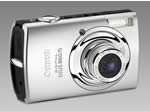
Promoted as "the photographer�s IXUS" by Canon, the new Digital IXUS 860 IS is one of the more intriguing models in Canon's Autumn lineup of compact digital cameras. The new Canon IXUS 860 IS offers an 8 megapixel sensor and a wide-angle 3.8x zoom lens equivalent to 28-105mm, complete with optical image stabilisation to help ensure that your photos are shake-free. There's also a large 3 inch LCD screen with 230,000 pixels and an anti-glare, scratch-resistant coating. Canon's DIGIC III image processor, which is also used in its DSLR camera range, powers the IXUS 860 IS behind the scenes, and additionally provides the camera's Face Detection and Noise Reduction technologies. There's a new Red-Eye Correction feature on offer in Playback mode, a range of ISO speeds up to 1600 and a new ISO Auto Shift function to help avoid image blur whenever camera shake is predicted. So is the stylish Canon Digital IXUS 860 IS really a great compact camera for the more serious photographer? Read our in-depth review to find out.
Compare Prices
Support PhotographyBLOG: Buy the Canon Digital IXUS 860 IS from one of our affiliate retailers:Ease of Use
The Canon Digital IXUS 860 IS is a very well-made compact digital camera, with a stylish two-tone black and silver metal and plastic body and excellent overall finish. It has a pleasingly simplistic, clean overall design, with a pronounced curve on the right-hand side (looking from the back of the camera). If you require a pocket camera that is good-looking, then look no further - I'd go so far to say that this is the most well designed IXUS yet. The Canon Digital IXUS 860 IS is easily small enough to fit into the palm of your hand, weighing 155g without the battery or memory card fitted. Most aspects of the design and build have a quality feel with nothing really feeling flimsy or ill-thought out. There are a few minor criticisms that can be leveled at the Canon Digital IXUS 860 IS, mostly concerning the various covers. The plastic A/V Out / Digital port cover on the right side of the camera feels a little flimsy, as does the battery/memory card compartment cover, which is also trickier to open than it really should be. Otherwise the Canon Digital IXUS 860 IS scores top marks for its general design and build quality.
The Canon Digital IXUS 860 IS is comfortable to hold, despite being such a small camera. Both thumbs naturally support the bottom of the camera, whilst operating the shutter button with your right index finger. You can also comfortably hold the camera and take pictures with one hand. The camera is not too slippy when gripping it thanks to the use of a tactile black plastic strip which runs around the full length of the camera. The various buttons are well-made and easy to operate, and the camera feels well-balanced in your hands. There are no real innovative features here, but everything that the Canon Digital IXUS 860 IS does, it does extremely well. Overall the Canon Digital IXUS 860 IS is well constructed and designed with no obvious signs of corners being cut. Even the tripod mount, traditionally a last minute thought on a camera like this, is (nearly) positioned in the center of the bottom of the camera.
Canon have followed the lead of other manufacturers, most notably Panasonic, by offering a wide-angle 3.8x zoom lens equivalent to 28-105mm on a 35mm camera. Previous IXUS cameras have typically had a 3x zoom lens that starts at 35mm or longer. The wide-angle lens on the IXUS 860 IS makes this one of the more versatile compacts in terms of focal range, especially as it is coupled with Canon's optical Image Stabilizer (IS) technology, which helps to ensure that the majority of photos taken in good light are sharp. If you're used to a standard 3x zoom lens which usually starts at around 35mm wide, then you will find that the lens on the IXUS 860 IS provides an entirely new angle of view that can only increase your creativity. Take it from me, you won't want to go back to a "standard" zoom after using a 28mm lens, especially as this example still offers a telephoto setting of 105mm which is perfect for head and shoulders portraits.
As with a growing number of pocket compact cameras, the Canon Digital IXUS 860 IS has an anti-shake system in the form of an optical Image Stabilizer. Turn this feature on on and the IXUS 860 IS automatically compensates for camera shake, which is a slight blurring of the image that typically occurs at slow shutter speeds or long telephoto focal lengths when the camera is hand held. There are three different modes. Continuous is on all the time including image composition, Shoot Only is only on when you press the shutter button, and Panning only corrects vertical movement, so that you can horizontally pan the camera to track a moving subject. In practice I found that it does make a noticeable difference, as shown in the examples on the Image Quality page. You don't notice that the camera is actually doing anything different when anti-shake is turned on, just that you can use slower shutter speeds than normal and still take sharp photos. Thankfully leaving the anti-shake system on didn't negatively affect the battery-life, with the camera managing over 200 shots using the supplied rechargeable Li-ion battery.
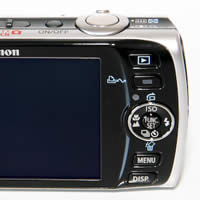 |
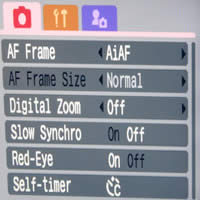 |
| Rear Controls | Main Menu |
The Canon Digital IXUS 860 IS has relatively few external controls, just 10 in total, reflecting the fact that this is strictly a point and shoot camera in functionality terms. Cleverly you can directly access the various flash, macro and timer options by clicking on the navigation pad, and Canon have also dedicated the Up position to ISO speed, which is a commonly used feature. There is also a sub-menu accessed via the Func/Set button in the middle of the navigation pad, which allows you to set exposure compensation, white balance, image effects, metering and image size/quality settings. This system is a good compromise given the small size of the camera and therefore the limited space for external controls. Canon have positioned the Movie / Scene Mode / Camera switch onto the top of the camera, which provides quick access to all the main shooting modes. All 10 external controls are clearly labeled using industry-standard symbols and terminology. Overall the camera body feels very well-designed and not at all cluttered, despite the presence of the large 3 inch LCD screen. As a result there is no room for an optical viewfinder, which would have been welcome for moments when it is difficult to use the LCD screen i.e. in very bright sunlight.
The Manual mode setting on the Canon Digital IXUS 860 IS may make you think that this camera offers full photographic control, but sadly it doesn't. Manual mode is just Canon's way of giving you access to more "advanced" features, like setting the ISO speed and White Balance. The Canon Digital IXUS 860 IS is purely a point and shoot camera with absolutely no control over aperture or shutter speed. It does, however, have some features that you won't find on other digital cameras. Press the Function button and select the My Colors option to reveal the Custom Color menu, which includes a number of pre-set looks, such as Positive Film and Vivid Green. These are a quick way of achieving a particular effect. More exciting are the Color Accent and Color Swap options in the shooting mode menu. Color Accent allows you to select one colour and render the rest of the image in black and white, whilst Color Swap lets you select a colour in the image and change it for another completely different one. Canon are the only manufacturer to offer what is quite an advanced feature directly in their cameras.
Face Detection is a new feature that's rather buried away. You have to press the dedicated Menu button and then choose face detection from the AiAF mode options. Rival compact cameras have a dedicated button for this feature, so it's a curious decision by Canon to bury it away within the menu system. The new face detection feature won't make a great deal of difference for the more experienced photographer, as there's the tendency for the user to pre-focus on the subject � and obviously a face if taking a portrait � before fully pressing the shutter button. It will prove more useful for the novice point and shoot user though. I didn't notice any notable difference between the AiAF On and AiAF Face Detection settings in terms of speed, so I just set the camera to the latter.
The new ISO Auto Shift function is more useful, providing a quick way to boost the ISO speed when the camera is struggling to provide a fast enough shutter speed for the prevalent lighting conditions. Turn this feature on, and when the IXUS 860 IS displays the red camera shake icon on the LCD screen, the round Print/Transfer button on the rear of the camera flashes blue. Press this whilst half-pressing the shutter button, and the camera sets a much faster ISO speed (typically ISO 800), which is usually enough to allow you take the shot and avoid camera shake. Quite a clever and quick way to access a more usable ISO speed. On the IXUS 860 IS Canon have also added an "On" option to the ISO Auto Shift function, which automatically sets an appropriate ISO speed without any user interaction required via the Print/Transfer button. There are some notable limitations with ISO Auto Shift though, principally the inability to use it with flash. As an aside, you can also assign your favourite camera setting to the Print/Transfer button, with Exposure Compensation being a good choice.
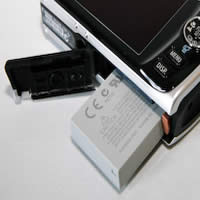 |
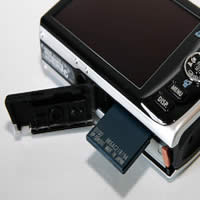 |
| Battery Compartment | Memory Card Slot |
The menu system on the Canon Digital IXUS 860 IS is extremely straight-forward to use and is accessed by a dedicated button underneath the navigation pad. Quite a lot of the camera's main settings, such as white balance, exposure compensation and ISO speed, are accessed elsewhere, so the main menu system isn't actually too complicated. A row of 3 icons along the top of the LCD screen represents the various sub-menus, with most of them being the kind that you set once and then forget about. Due to the very large and bright LCD screen, the various options are easy to access and use, especially as only 6 are shown onscreen at one time. If you have never used a digital camera before, or you're upgrading from a more basic model, reading the comprehensive and fairly easy-to-follow manual before you start is a good idea. Unfortunately Canon have chosen to cut costs and only supply it as a PDF on a CD, rather than in printed format. Not much use if you're taking pictures and need to find out what a particular option does.
The start-up time from turning the Canon Digital IXUS 860 IS on to being ready to take a photo is very quick at around 1/2 second, and it takes about 3 seconds to zoom from the widest focal length to the longest, and back again. Focusing is very quick in good light and the camera happily achieves focus indoors or in low-light situations, helped by a powerful focus-assist lamp. The visibility and refresh rate of the 3 inch LCD screen are perfectly acceptable, and the resolution is fine. It takes about 1 second to store an image, allowing you to keep shooting as they are being recorded onto the memory card - there is no LCD blackout between each image. In Continuous mode the camera can only manage 1.3 frames per second at the highest image quality, which is disappointing for this class of camera, but the shooting rate is maintained until your memory card is full. All in all the Canon Digital IXUS 860 IS is quite fast in terms of operational speed.
Once you have captured a photo, the Canon Digital IXUS 860 IS has an excellent range of options when it comes to playing, reviewing and managing your images. You can scroll through the images that you have taken, view thumbnails, zoom in and out up to 10x magnification, view slideshows with lots of different user settings, delete, protect, resize and rotate an image. You can also add a sound clip to an image, use the camera as a sound recorder, set the print order and the transfer order. There's a new red-eye correction option, and you can apply any of the 10 different My Colors options to a photo after you have taken it. My Category allows you to sort your images into various preset categories, with 3 custom categories available. The Display button toggles detailed settings information about each picture on and off, such as the ISO rating and white balance. It also shows overexposed parts of the image as flashing on and off, and there is a small histogram available during playback which is helpful in evaluating the exposure. Pressing the Display button for a fourth time accesses a new screen, which shows an enlarged section of the image alongside a small thumbnail. This is perfect for checking if the image is sharp and in focus, and you can scroll around the image to as you wish.
In summary the Canon Digital IXUS 860 IS is a stylish, well designed point-and-shoot compact camera with a very appealing wide-angle lens and excellent LCD screen.
|
![]() PhotographyBLOG
is a member of the DIWA
organisation. Our test results for the Canon Digital IXUS 860 IS have been submitted to DIWA
for comparison with test results for different samples of
the same camera model supplied by other DIWA
member sites.
PhotographyBLOG
is a member of the DIWA
organisation. Our test results for the Canon Digital IXUS 860 IS have been submitted to DIWA
for comparison with test results for different samples of
the same camera model supplied by other DIWA
member sites.
